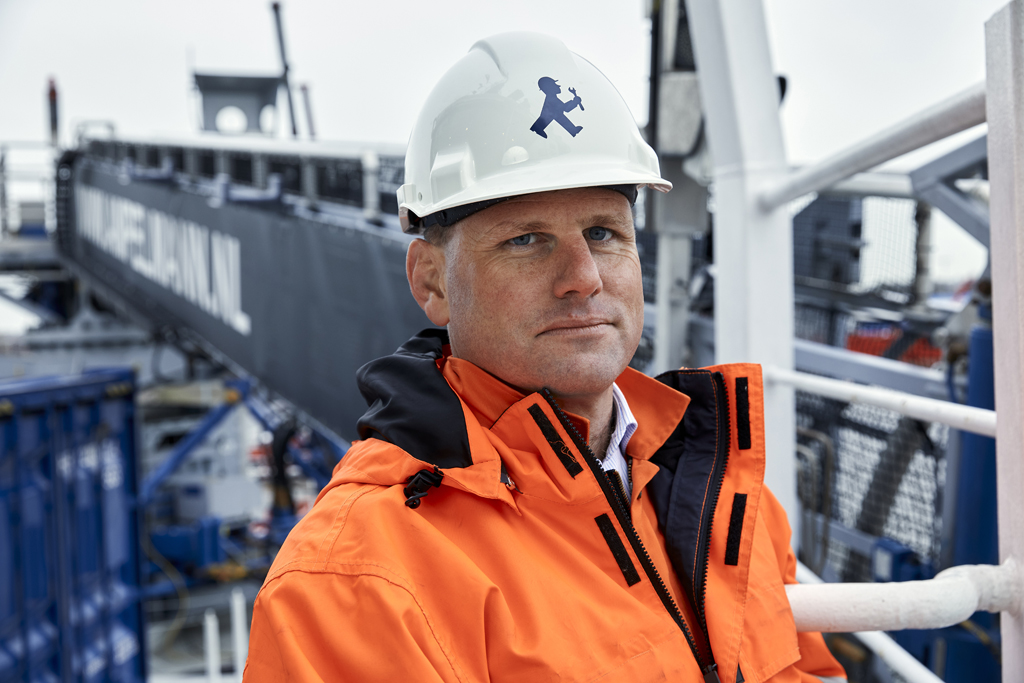TU Delft alumnus Jan van der Tempel is one of three inventors to have reached the finals of the European Inventor Award competition. He developed the Ampelmann gangway.
Jan van der Tempel makes passages between ships and platforms as safe as crossing the road. (Photo: EPO)
The Ampelmann gangway allows safe passage between ships or between ships and platforms, even in heavy seas (up to four metres wave height). Since its first production in 2007, some 65 systems are now in use worldwide and have transferred an estimated six million offshore workers and 17 million kilograms of cargo.
Its inventor, Dr Jan van der Tempel (1974), has been the Managing Director of Ampelmann Operations since its founding. Van der Tempel has now been nominated by the European Patent Office (EPO) for the European Inventor Award in the industry category. His two co-nominated inventors developed a better puffer for administering medicine through the nose (Per Gisle Djupesland from Norway), and used CO2 to produce green plastic (Christoph Gürthler and Walter Leitner from Germany). The jury’s criteria is inventions that offer solutions to prevailing problems.
With the European Inventor Award, which has existed since 2006, the EPO is striving to underline the importance of patents: through the protection of intellectual property, a brilliant idea can grow into an invention that really changes the world. How did this work out for Jan van der Tempel?
He named his idea after the iconic Berlin traffic light man: der Ampelmann
Trained as an offshore wind engineer, Van der Tempel attended a specialist conference in Berlin in 2002. There, he came up with the idea of a dynamic hydraulic walkway for offshore applications. He envisaged an inverted aircraft simulator that would not make movements that corresponded to the screens, but that would nullify the movements of a ship on the waves. He named his idea after the iconic Berlin traffic light man: der Ampelmann.
Van der Tempel then developed the technology which has a motion sensor the size of a shoebox on board the ship. A fast computer system converts the ship’s movements into the controls of six hydraulic cylinders that compensate for each movement by adjusting their lengths. Van der Tempel says offshore workers now go to work as easily as they cross the street. In 2007, he founded the company Ampelmann Operations.
After the success of his prototype developed at TU Delft, Van der Tempel applied for a patent to protect his invention. He received his first European patent in 2012, followed by a second in 2014. Two more followed in 2019 and 2020.
“Our solution is the only one with cylinders that work in six directions and reach a fully stationary point with only millisecond delays,” says Van der Tempel. “The patent protects our concept, and this gives our company a huge advantage in the marketplace over the competition. It allowed us to grow and make our company what it is today: a company with 350 employees.”
Ampelmann Operations started off in supplying the oil and gas industry, but now also has a good track record in the offshore wind industry – a sector that is expected to grow significantly until 2050 and will require maintenance thereafter.
In addition to ‘industry’, the EPO competition also has other categories: research, small and medium-sized enterprises, non-EPO countries, and a personal award. In addition, there is a public prize for which anyone can cast a vote.
- The results will be announced in the evening of 17 June via a live stream open to the public
Mini documentary about the development of the Ampelmann featuring unique archive footage (7 mins)
Read also:
‘Amplemann hits major milestone’ (2015)
Do you have a question or comment about this article?
j.w.wassink@tudelft.nl


Comments are closed.